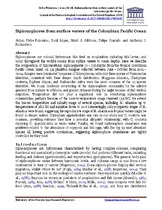| dc.description.abstract | Siphonophores are colonial hydrozoans that feed on zooplankton including fish larvae, and occur throughout the world’s oceans from surface waters to ocean depths. Here we describe the composition of hyponeustonic siphonophores (0 – 3 m depth) from the tropical Colombian Pacific Ocean based on 131 plankton samples collected between June – October from 2001 – 2004. Samples were dominated by species of Calycophorae, with only three species of Physonectae identified, consistent with their deeper depth distribution. Muggiaea atlantica, Chelophyes contorta, Diphyes dispar, and Eudoxoides mitra were the most common of the 21 species identified. We found moderate structuring of the siphonophore community by the salinity gradient from inshore to offshore, and greater richness during the night because of diel vertical migration. Temperature did not play a significant role in structuring siphonophore communities, perhaps because of the narrow temperature range observed (3.5 8C). We extend the known temperature and salinity range of several species, including M. atlantica up to temperatures of 28.6 8C and salinities down to 24.7. Interestingly, only polygastric stages of M. atlantica were found, suggesting the reproductive stage of M. atlantica in tropical waters might be found in deeper waters. Chelophyes appendiculata was rare in our study and C. contorta was common, providing evidence they have a potential allopatric relationship, with C. contorta replacing C. appendiculata in warm water. Finally, we found siphonophore abundance was positively related to the abundance of copepods and fish eggs, with the top 13 most abundant species all having positive correlations, suggesting siphonophore abundances are tightly controlled by their food. | en_US |

